List of works by Edwin Lutyens
This list of works by Edwin Lutyens provides brief details of some of the houses, gardens, public buildings and memorials designed by Sir Edwin Landseer Lutyens (1869–1944).

Lutyens was a British architect known for imaginatively adapting traditional architectural styles to the requirements of his era. The architectural historian Gavin Stamp described him as "the greatest British architect of the twentieth (or of any other) century"[1] and English Heritage identify him as "one of the greatest architects the country has ever produced".[2] More than 500 of his creations have been placed on the National Heritage List for England.[2]
United Kingdom
Houses and gardens
| Name | Image | Location | County | Initiated | Completed | Notes |
|---|---|---|---|---|---|---|
| Abbey House 54.13869°N 3.20019°W |  | Barrow-in-Furness | Cumbria | 1910 | 1914 | Guest-house built in the Tudor Revival style, of red ashlar and slate, for Vickers Ltd.[3] |
| Abbotswood 51.93496°N 1.73796°W |  | Lower Swell | Gloucestershire | 1901 | 1901 | Alterations to an existing property, and the design of gardens, for Mark Fenwick, a banker and mine owner.[4] |
| Castle Drogo 50.69587°N 3.81115°W |  | Drewsteignton | Devon | 1911 | 1930 | English country house borrowing styles of castle-building from the medieval and Tudor periods, along with more minimalist contemporary approaches. |
| Deanery Garden 51.47447°N 0.91138°W | _(14763542872).jpg.webp) | Sonning | Berkshire | 1899 | 1901 | Arts and Crafts style house with garden laid out by Lutyens and planted by garden designer Gertrude Jekyll;[5] one of the several commissions from Edward Hudson, founder of Country Life magazine. |
| Folly Farm 51.41574°N 1.09424°W | _(14760809361).jpg.webp) | Sulhamstead | Berkshire | 1906 | 1912 | Built around a 17th-century farmhouse, to which Lutyens made extensions in a neoclassical style around 1906, and then in a vernacular style around 1912, for metals trader Zachary Merton. |
| Goddards 51.19676°N 0.39812°W | 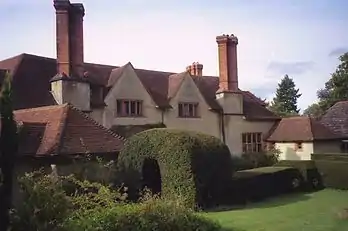 | Abinger | Surrey | 1898 | 1900 | In a Tudor style, with gardens by Gertrude Jekyll, commissioned for charitable purposes by shipping magnate Frederick Mirrielees. |
| Heathcote 53.92456°N 1.83636°W | 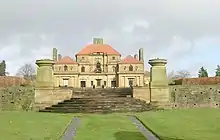 | Ilkley | West Yorkshire | 1906 | 1908 | Villa representing Lutyens first comprehensive use of the Neoclassical style,[6] and the precursor of later buildings in Edwardian Baroque style and those of New Delhi.[7] Built for John Thomas Hemingway, wool merchant. |
| Hestercombe Gardens 51.05220°N 3.08372°W | .jpg.webp) | West Monkton | Somerset | 1904 | 1906 | Lutyens and Gertrude Jekyll laid out an Edwardian garden at Hestercombe House between 1904 and 1906 for the Hon E.W.B. Portman,[8] |
| Lindisfarne Castle 55.66902°N 1.78481°W |  | Lindisfarne | Northumberland | 1901 | 1914 | 16th Century castle remodelled as an Arts and Crafts style family home for Edward Hudson |
| Little Thakeham 50.93035°N 0.42322°W | _(14577261528).jpg.webp) | Horsham | Sussex | 1902 | 1903 | Arts and Crafts style, Grade I listed private house designed for Ernest Blackburn, a pre-school headmaster who inherited a fortune, it is the first in which Lutyens mixed neoclassical architecture into his previously vernacular style.[9][10] |
| Marshcourt 51.10069°N 1.49223°W | _(14577428047).jpg.webp) | Marsh Court, Stockbridge | Hampshire | 1901 | 1905 | Arts and Crafts style in ashlar, with a Tudor exterior employing lines of black flint and red tile.[11][12] Built for Herbert Johnson, a fortunate London Stock Exchange trader. |
| Middlefield 52.1545°N 0.1618°E | Stapleford | Cambridgeshire | 1908 | 1909 | Red-brick mansion with prominent chimneystacks and large hipped roofs, designed for Henry Bond, a Cambridge don.[13] | |
| Munstead Wood 51.17516°N 0.59648°W | _(14760674751).jpg.webp) | Munstead Heath, Busbridge | Surrey | 1889 | 1897 | A very early commission for Gertrude Jekyll, an Arts and Crafts style house inspired by local vernacular architecture. |
| New Place 50.9186°N 1.1953°W |
 |
Shirrell Heath | Hampshire | 1904 | 1906 | Incorporates the interior of an early 17th century mansion in Bristol. Now a hotel.[14] |
| Orchards 51.18002°N 0.58133°W | _(14577220558).jpg.webp) | Bramley | Surrey | 1897 | 1899 | Like Munstead Wood, an Arts and Crafts style house inspired by local vernacular architecture, an early commission for William and Julia Chance. |
| Overstrand Hall 52.91863°N 1.33152°E | 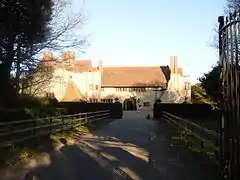 | Overstrand | Norfolk | 1899 | 1901 | Pevsner describes it as "one of [Lutyens's] most remarkable buildings"[15] employing a range of materials drawing from diverse architectural styles. |
| Tigbourne Court 51.13255°N 0.63395°W | 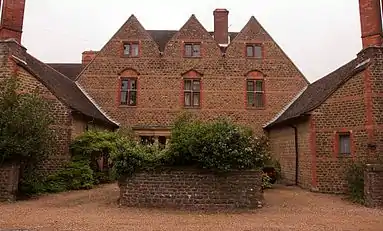 | Wormley | Surrey | 1899 | 1901 | In an Arts and Crafts style strongly influenced by local vernacular architecture, built for businessman Edgar Horne. Described by Ian Nairn as "probably [Lutyens's] best" building.[16] |
Bridges
| Name | Image | Location | County | Initiated | Completed | Notes |
|---|---|---|---|---|---|---|
| Hampton Court Bridge 51.40375°N 0.34240°W | 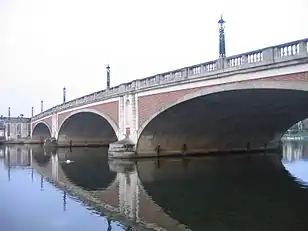 | Hampton and East Molesey | London and Surrey | 1928 | 1933 | A three-arch reinforced concrete bridge with brick facings and Portland stone balustraded parapets, abutments and niches, spanning the River Thames near to Hampton Court Palace. Designed with Surrey county engineer W. P. Robinson to reflect the style of Sir Christopher Wren's work at the Palace.[17][18] |
| Runnymede Bridge 51.4375°N 0.534722°W |  | Egham and Staines-upon-Thames | Surrey | 1939 | 1961 | Encased-steel-arch bridge over the River Thames, designed by 1939 to carry the A30 road; but not constructed for 15-years after Lutyens' death, World War II having intervened. Design details – the use of brick-facing and Portland stone, albeit without niches – follow the style of the Hampton Court Bridge.[19] |
| Silver Street Bridge 52.2019°N 0.1154°E |  | Cambridge | Cambridgeshire | 1932 | 1959 | Over the River Cam in central Cambridge[20] |
Public buildings
| Name | Image | Location | County | Initiated | Completed | Notes |
|---|---|---|---|---|---|---|
| 100 King Street 53.48058°N 2.24225°W | 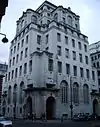 | Manchester | Greater Manchester | 1928 | 1935 | A castle-like Art Deco building surrounded on all four sides by roads, and featuring carvings by the local sculptor John Ashton Floyd; built for the Midland Bank.[21] |
| Benson Court, Magdalene College 52.20975°N 0.1154°E | 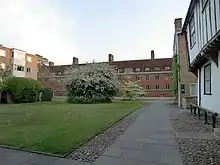 | Cambridge | Cambridgeshire | 1932 | Student accommodation.[22][23] | |
| BMA House 51.52592°N 0.12893°W | 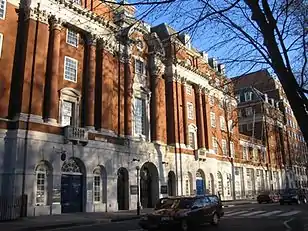 | Tavistock Square | Central London | 1911 | 1925 | Headquarters building originally designed for the Theosophical Society with construction taken over by the British Medical Association |
| Grosvenor Estate 51.49393°N 0.13019°W |
.jpg.webp) |
London | Westminster | 1928 | 1930 | This 600-dwelling estate is the only housing project of Lutyens. It is composed of seven 'U'-shaped five and six-storey buildings, recognizable by their chess-board like façade.[24] The estate's status was the subject of a 1990 legal case, Westminster City Council v Duke of Westminster. |
| Henrietta Barnett School 51.5811°N 0.1892°W | 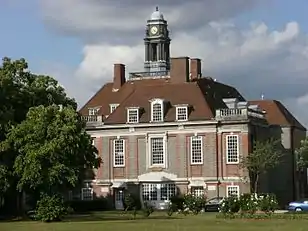 | Hampstead Garden Suburb | North London | 1911 | Girls' Grammar school founded in 1911 by Dame Henrietta Barnett. | |
| Linden Lodge School 51.44370°N 0.21320°W | Wimbledon | South London | 1934 | 1934 | Residential school for visually-impaired children | |
| St Mary's Church 51.23964°N 0.31648°W | .jpg.webp) | Pixham, Dorking | Surrey | 1903[25] | Chapel of ease to Dorking parish church, having a barrel-vaulted ceiling. Grade II* listed. |
Memorials
| Name | Image | Location | County | Initiated | Completed | Notes |
|---|---|---|---|---|---|---|
| Abinger Common War Memorial 51.20146°N 0.40552°W |  | Abinger Common | Surrey | 1920, 1949 | Lutyens' War Cross design; the original 1920 erection was destroyed by bombing in 1944, and a replacement cross erected in 1949.[26][27] | |
| Arch of Remembrance 52.62343°N 1.12156°W |  | Leicester | Leicestershire | 1919 | 1925 | A monumental tetrapylon quadrifrons triumphal arch in a railed enclosure; Lutyens was selected as architect by the War memorial Committee.[28] |
| Ashwell War Memorial 52.04316°N 0.14595°W | 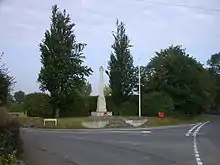 | Ashwell | Hertfordshire | 1919 | 1922 | Lutyens' War Cross design, the commission offered to a shortlist of three providers, Lutyens being selected.[29] |
| British Thomson-Houston Company War Memorial 52.38277°N 1.25509°W |  | Rugby | Warwickshire | 1921 | 1921 | Lutyens' War Cross design, commissioned by the British Thomson-Houston Company to honour its employee war-dead.[30] |
| Busbridge War Memorial 51.17751°N 0.60210°W |
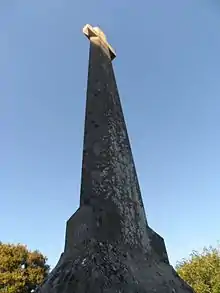 |
Busbridge | Surrey | 1922 | Lutyens connection to Busbridge was with Gertrude Jekyll, for whom he designed Munstead Wood on the outskirts of the village. The memorial is of Lutyens' War Cross design. | |
| The Cenotaph 51.50267°N 0.12609°W |  | Whitehall | Central London | 1919 | 1920 | The site of the British annual National Service of Remembrance. Originally a wood-and-plaster structure designed by Lutyens and erected in 1919, later replaced by a replica in Portland stone and taking the form of a pylon rising in a series of set-backs to an empty tomb (cenotaph) on its summit. The model for cenotaphs around the world. |
| Civil Service Rifles War Memorial 51.51039°N 0.11761°W |
.JPG.webp) |
London | Greater London | 1924 | Single rectangular column of Portland stone, decorated with classical mouldings, standing approximately 4.9 metres (16 feet) tall and surmounted by a cornice, plinth and sculpture of an urn; located on the Thames-side of Somerset House. | |
| Devon County War Memorial 50.72265°N 3.53151°W |
.JPG.webp) |
Exeter | Devon | 1921 | 30-foot (9.1-metre) granite cross, quarried from Haytor on Dartmoor, and hewn from a single stone—the largest Lutyens was able to acquire; situated outside and in line with the central axis of Exeter Cathedral. | |
| Fordham War Memorial 52.31147°N 0.39055°E |
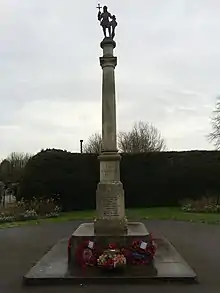 |
Fordham | Cambridgeshire | 1921 | Doric column in Portland stone surmounted by a bronze statue of Saint George, sculpted by Sir George Frampton, who also contributed the sculpture for Hove War Memorial. | |
| Francis McLaren headboard 51.17693°N 0.60139°W |
 |
Busbridge | Surrey | Carved oak headboard marking the grave of Francis McLaren, son-in-law of Agnes Jekyll.[31] | ||
| Gerrards Cross Memorial Building 51.58358°N 0.55169°W |
.jpg.webp) |
Gerrards Cross | Buckinghamshire | 1922 | Single story community-centre, with a memorial plaque sheltered beneath a portico supported by four doric columns | |
| Hannen Columbarium 51.49948°N 0.87339°W |  | Wargrave | Berkshire | 1905 | 1907 | Columbarium combining Byzantine Revival with Arts and Crafts and with classical architectural lines, in the form of a 12 feet (3.7 m) square building of red-brick, red-tile, glass-tile and stonework.[32][33] Lutyen's earliest mausoleum design, recognised as an embodyment of the point at which he fully incorporated classical architecture in his designs.[34] |
| Hartburn War Memorial 55.16891°N 1.86176°W |  | Hartburn | Northumberland | 1921 | Lutyens' War Cross design, commissioned by Mr and Mrs Straker of nearby Angerton Hall, the gardens of which Lutyens renovated with Gertrude Jekyll in 1904.[35] | |
| Holy Island War Memorial 55.66828°N 1.80065°W |  | Lindisfarne | Northumberland | 1922 | A grade II* listed First World War memorial in local pink ashlar stone, recognised as part of a "national collection" of Lutyens memorials.[36][37] | |
| Hove War Memorial 50.82683°N 0.16867°W |
.JPG.webp) |
Hove | Sussex | 1921 | Bronze statue of Saint George holding a sword by the blade below the hilt, sculpted by Sir George Frampton, standing on a grey granite Doric column. Frampton was also the sculptor for Fordham War Memorial | |
| Jekyll family memorial 51.17694°N 0.60135°W |
 |
Busbridge | Surrey | Gravestones and memorial commemorating Gertrude Jekyll, Agnes Jekyll and Herbert Jekyll.[38] | ||
| King's Somborne War Memorial 51.07735°N 1.48727°W |
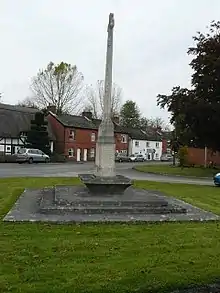 |
King's Somborne | Hampshire | 1922 | Lutyens' War Cross design; his connection with the village was Herbert Johnson, for whom he designed Marshcourt[39] | |
| Lancashire Fusiliers War Memorial 53.59226°N 2.29872°W |
.JPG.webp) |
Bury | Greater Manchester | 1922 | Single tall, tapering obelisk in Portland stone (similar to the pair on Lutyens' Northampton War Memorial) standing on a square base with a cornice, below which is a carved frieze on a pedestal of two rectangular blocks, mounted on a rectangular plinth and at the very bottom are two shallow circular steps. | |
| Leeds Rifles War Memorial 53.79532°N 1.53543°W |
 |
Leeds | West Yorkshire | 1921 | Small version of the Lutyens' War Cross, set into the church wall of Leeds Minster and facing out onto Kirkgate, in Portland stone. The memorial incorporates a stone bench which doubles as a platform for wreaths. | |
| Lower Swell War Memorial 51.92801°N 1.74871°W |  | Lower Swell | Gloucestershire | 1921 | Lutyens' War Cross design; his connection with the village was with Mark Fenwick, for whom Lutyens renovated the nearby Abbotswood house.[40] | |
| Manchester Cenotaph 53.47870°N 2.24295°W |
 |
Manchester | Greater Manchester | 1922 | 1924 | Cenotaph, flanked by twin obelisks, and a Stone of Remembrance, all in Portland stone on a raised coved platform; reminiscent of his earlier cenotaph in Southampton |
| Mells War Memorial 51.24090°N 2.38933°W |
.jpg.webp) |
Mells | Somerset | 1920 | Tuscan column of Purbeck Marble on which stands a statue of Saint George slaying a dragon. The memorial is one of many buildings and structures by Lutyens in the village by Lutyens for the Horner and Asquith families. | |
| Merchant Navy War Memorial 51.50957°N 0.07763°W |
.JPG.webp) |
Tower Hill | London | 1928 | Lutyens designed a World War I taking the form of a Doric temple, raised on a platform slightly above street level, oriented east to west and situated in Trinity Square Gardens on Tower Hill, within sight of the Tower of London.[41] A World War II monument designed by Edward Maufe was constructed to adjoin and complement Lutyens design.[42] | |
| Midland Railway War Memorial 52.91550°N 1.46490°W |
 |
Derby | Derbyshire | 1921 | 10-metre (33-foot) high cenotaph in the centre of a 2-metre (6.6-foot) screen wall forming rectangular alcoves on each side. At the top of the cenotaph is a recumbent effigy of an unknown soldier, partially covered by his greatcoat and with his helmet and bayonet at his feet.[43][44][45] | |
| Miserden War Memorial 51.77857°N 2.09385°W |
 |
Miserden, | Gloucestershire | 1920 | Typical Lutyens War Cross with a tapering shaft and short arms, of limestone construction.[46] | |
| Muncaster War Memorial 54.35760°N 3.40104°W | 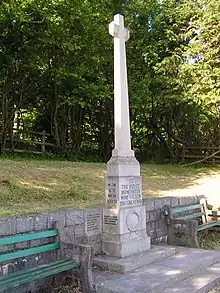 | Muncaster | Cumbria | 1922 | Lutyens' War Cross design; his connection with the village was Sir John Ramsden, for whom he consulted on Muncaster Castle[47] | |
| North Eastern Railway War Memorial 53.95868°N 1.08979°W |
 |
York | North Yorkshire | 1924 | Single, 30-foot (9-metre) obelisk rising from a three-tiered pedestal set into the rear portion of a three-sided screen wall.[48] | |
| Northampton War Memorial 52.23729°N 0.89574°W |
 |
Northampton | Northamptonshire | 1926 | A Stone of Remembrance flanked by tall twin obelisks, each adorned with a pair of painted stone flags.[49] | |
| Norwich War Memorial 52.62858°N 1.29234°E |
.jpg.webp) |
Norwich | Norfolk | 1927 | The memorial is of Portland stone construction, and comprises a low screen wall on top of which is a cenotaph topped with a carved wreath; it is the last of eight cenotaphs by Lutyens.[50] | |
| Oxfordshire and Buckinghamshire Light Infantry War Memorial 51.73233°N 1.22830°W |
 |
Oxford | Oxfordshire | 1923 | The memorial consists of a single obelisk mounted on a moulded pedestal and a plain square base, approached by three shallow steps.[51] | |
| Queen's Own Royal West Kent Regiment Cenotaph 51.27715°N 0.52037°E |
.jpg.webp) |
Maidstone | Kent | 1921 | A two-thirds scale replica of Whitehall's cenotaph and unadorned by flags.[52] | |
| Rolvenden War Memorial 51.05085°N 0.63060°E | 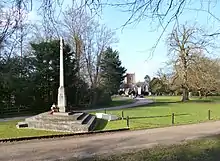 | Rolvenden | Kent | 1922 | Unique amongst Lutyens' War Cross designs, being slender and sparse; his connection with the village was Harold Tennant for whom he had designed the nearby Great Maytham Hall[53] | |
| Rochdale Cenotaph 53.61628°N 2.15971°W |
.JPG.webp) |
Rochdale | Greater Manchester | 1922 | Comprising two elements: a 10-metre (33 ft) pylon and a Stone of Remembrance formed from light grey Cornish granite which are raised on a platform (stylobate) of three steps.[54][55] | |
| Royal Berkshire Regiment War Memorial 51.45826°N 1.00439°W |
Reading | Berkshire | 1921 | Customary Lutyens' cenotaph memorial, standing on a base of three steps and in Portland stone; at the very top of the structure is an urn.[56] | ||
| Royal Naval Division War Memorial 51.50535°N 0.12908°W |
.JPG.webp) |
Whitehall | London | 1925 | An obelisk rising from a circular bowl, supported by a moulded square base which connects to a second, shallower bowl and then to a large square plinth.[57][58] | |
| Sandhurst War Memorial 51.02682°N 0.56318°E |  | Sandhurst | Kent | 1923 | A Lutyens' War Cross design; Lutyens connection with the village was a local resident, James Wilson[59] | |
| Southampton Cenotaph 50.90965°N 1.40515°W |
.jpg.webp) |
Southampton | Hampshire | 1920 | The design is a pylon surmounted by a sarcophagus bearing a recumbent effigy of a fallen soldier—raised on five stone steps; in front of the cenotaph is a Stone of Remembrance raised on two further steps.[60] | |
| South African War Memorial 51.45690°N 0.28662°W |
 |
Richmond | Surrey | 1921 | A cenotaph, constructed in coarse granite to a design modelled on the Whitehall cenotaph. Unusually among Lutyens' memorials, it has a triangular top. It has a flared base and sits on a base of two stone steps, in contrast to the three on which most of Lutyens' memorials stand.[61] | |
| Southend-on-Sea War Memorial 51.53423°N 0.70495°E |
 |
Southend-on-Sea | Essex | 1921 | Lutyens first proposed a cenotaph for Southend-on-Sea, but changed his plans to deliver a tapering Portland stone obelisk rising to approximately 11 metres (36 feet) tall, sitting on a square base with a moulded cornice above a rectangular pedestal of six unequal-sized stones, all similar in form to his contemporaneous North Eastern Railway War Memorial. | |
| Spalding War Memorial 52.78353°N 0.14927°W |
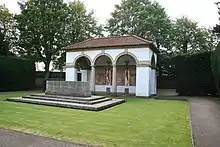 |
Spalding | Lincolnshire | 1922 | Spalding's memorial takes the form of a brick pavilion in front of which is a 12 feet (3.7 metres) long Stone of Remembrance; both are situated at the head of a long reflecting pool, which incorporates the remains of an 18th-century canal. Lutyens' commission came from Barbara Freyberg, who lost her husband in the Great War, and who was a niece of Lutyens' garden-designer colleague and client Gertrude Jekyll. | |
| Stockbridge War Memorial 51.11341°N 1.48763°W | 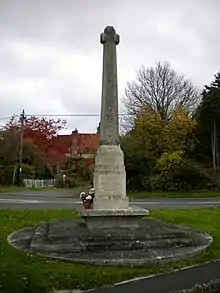 | Stockbridge | Hampshire | 1922 | Lutyens' War Cross design; his connection with the village (as with King's Somborne) was Herbert Johnson, for whom he designed Marshcourt[62] | |
| Wargrave War Memorial 51.49926°N 0.87210°W |  | Wargrave | Berkshire | 1922 | Lutyens' War Cross design, commissioned by a 1919 public meeting, possibly influenced by Lutyens' connections with the Hannon family for whom he also designed the Hannen Columbarium[63] | |
| Welch Regiment War Memorial 51.49831°N 3.18419°W |
 |
Cardiff | South Glamorgan | 1924 | Originally planned as a memorial to be erected near Gheluvelt on the Western Front in Belgium, Lutyens' design for a cenotaph in Portland stone standing on a stepped plinth and a square base was instead erected at Maindy Barracks in Cardiff. | |
| York City War Memorial 53.95993°N 1.08952°W |
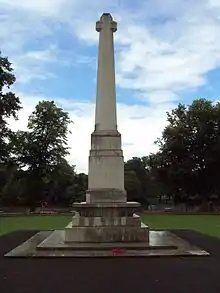 |
York | North Yorkshire | 1925 | Lozenge-shaped shafted cross with short, chamfered arms. Lutyens' work extends to the entrance gates and supporting piers. The memorial project proved controversial prior to and throughout Lutyens' involvement: whether the memorial should be utilitarian or monumental; and whether the proposed monument and its situation would be in keeping with York architecture.[64] |
India
Lutyens was invited, with others, in 1912 to advise the Government of India on planning for a proposed new centre of government to be built in Delhi and named New Delhi. He became the project's leading architect, giving rise to Lutyens' Delhi, encompassing the street plan and key government buildings, and his name is lent to the Lutyens Bungalow Zone of domestic properties for government officers (albeit Lutyens was directly responsible for the design of only four of the houses). A number of other architects, notably Herbert Baker, were responsible for the city's other key buildings.
| Name | Image | Initiated | Completed | Notes |
|---|---|---|---|---|
| Baroda House 28.61685°N 77.23047°E | 1921 | 1936 | Residence of the Maharaja of Baroda in Delhi | |
| Hyderabad House 28.61601°N 77.22789°E |  | 1926 | 1928 | Residence of Osman Ali Khan, Nizam VII, an amalgam of the Mughal and European architecture |
| India Gate 28.61290°N 77.22951°E |  | 1917 | 1931 | A memorial to the dead of the British India Army in World War I, in the form of a triumphal arch. |
| Jaipur Column 28.614262°N 77.201902°E | 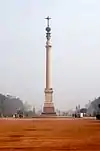 | 1912 | 1930 | Monumental column celebrating the 1911 Delhi Durbar and the transfer of the capital of India from Calcutta to Delhi.[65] |
| Janpath 28.61432°N 77.21854°E |  | 1931 | Janpath – "people's way" – is the main north–south road through New Delhi, the layout of which was planned by Lutyens. | |
| National Archives of India 28.61546°N 77.21716°E | One of a planned four museum buildings to occupy quadrants around the intersection of Janpath and Rajpath, the National Archives building was the only one constructed. | |||
| Patiala House 28.61536°N 77.23474°E | The former residence of the Maharaja of Patiala, now a district court building. | |||
| Rajpath 28.61352°N 77.21729°E | 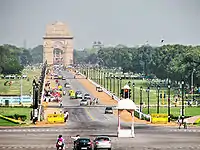 | 1931 | Rajpath – "King's way" – is an east–west ceremonial boulevard through the centre of New Delhi, linking Rashtrapathi Bhavan with India Gate, and location for the annual Delhi Republic Day parade. | |
| Rashtrapathi Bhavan 28.61440°N 77.19948°E | 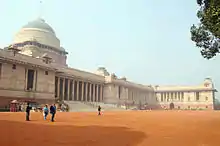 | 1912 | 1929 | Designed as the Viceroy's House for the Governor-General of India during the British Raj period, and now the official home of the President of India[66] |
Ireland
| Name | Image | Location | County | Initiated | Completed | Notes |
|---|---|---|---|---|---|---|
| Howth Castle 53.3863°N 6.079°W | 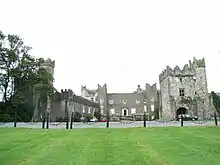 | Howth | Fingal | 1910 | Renovation of fourteenth-century castle[67] | |
| Irish National War Memorial Gardens 53.344°N 6.317°W | 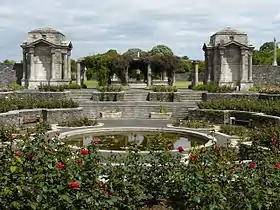 | Islandbridge | County Dublin | 1930 | 1940 | [68] |
| Lambay Castle 53.3863°N 6.079°W | 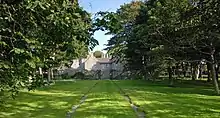 | Lambay Island | County Dublin | 1905 | 1912 | - |
| Tranarossan House 55.2292°N 7.8037°W |  | near Downings | County Donegal | - | Now Trá na Rosann youth hostel [69][70] | |
| Costelloe Lodge 53.2787°N 9.5368°W | – | Casla (Costelloe) | County Galway | – | – | Built for J. Bruce Ismay, chairman of the White Star Line, much-criticised survivor of the sinking of the Titanic.[71] |
| Heywood House Gardens52.8843°N 7.3008°W | – | Ballinakill | County Laois | – | – | New gardens for an existing house for Sir Hutchinson-Poe[72] |
France
| Name | Image | Location | Department | Initiated | Completed | Notes |
|---|---|---|---|---|---|---|
| Australian National Memorial 49.8869°N 2.5128°E | _1.jpg.webp) | Villers-Bretonneux | Somme | 1935 | 1938 | Memorial to Australian military personnel killed on the Western Front during World War I, listing names of over 10,000 soldiers of the Australian Imperial Force with no known grave. Lutyens also designed the cemetery.[73] |
| Bois des Moutiers 49.91182°N 0.98326°E | 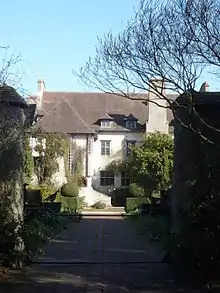 | Varengeville-sur-Mer | Normandy | 1911 | 1930 | Remodelling of an existing 1850s house in the Arts and Crafts style by Lutyens, with gardens laid out by Lutyens and Gertrude Jekyll. |
| Thiepval Memorial 50.05058°N 2.68573°E |  | Thiepval | Picardy | 1928 | 1932 | Memorial to 72,195 British and South African men who died in the Battles of the Somme of the First World War between 1915 and 1918 and have no known grave. |
Italy
| Name | Image | Location | Initiated | Completed | Notes |
|---|---|---|---|---|---|
| British School at Rome 41.918772°N 12.481386°E |
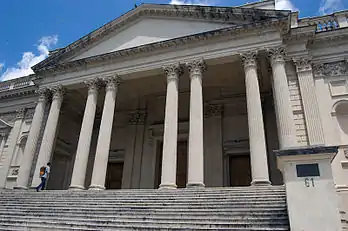 |
Rome | 1912 | 1916 | Built on the site of the British Pavilion at the 1911 International Exhibition of Art to provide a permanent residential research institute.[74] |
South Africa
| Name | Image | Location | Initiated | Completed | Notes |
|---|---|---|---|---|---|
| Anglo-Boer War Memorial 26.164°S 28.041°E |  | Johannesburg | 1910 | 1914 | Originally called the Rand Regiments Memorial, this arch was erected in honour of the British soldiers who fell in the second Anglo-Boer War. |
| Johannesburg Art Gallery 26.197039°S 28.047104°E | 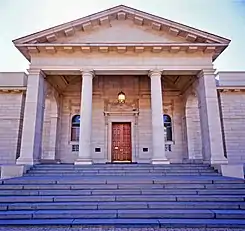 | Johannesburg | 1910 | 1915 | An Art Gallery in Johannesburg designed by Edwin Lutyens with Robert Howden working as supervising architect. It is the largest art gallery in South Africa. |
United States
| Name | Image | Location | State | Initiated | Completed | Notes |
|---|---|---|---|---|---|---|
| British Ambassador's residence 38.92109°N 77.06300°W |  | Northwest Washington | District of Columbia | 1925 | 1928 | An example of Queen Anne architecture, the embassy residence was the only building Lutyens designed in North America. |
Unrealised work
| Name | Image | Location | Country | Initiated | Completed | Notes |
|---|---|---|---|---|---|---|
| Liverpool Metropolitan Cathedral 53.40498°N 2.96850°W | 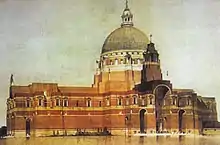 | Liverpool | UK | 1930 | 1958 | Lutyens was commissioned to design a new Cathedral, but rising costs caused the abandonment of the scheme; his design for the crypt was realised and completed in 1958.[75] |
References
- Stamp, Gavin (2006). The Memorial to the Missing of the Somme (2007 ed.). London: Profile Books. p. 10. ISBN 978-1-86197-896-7.
- Historic England. "Silver Street Bridge (1409450)". National Heritage List for England. Retrieved 14 April 2018.
- Historic England. "Abbey House Hotel (1197910)". National Heritage List for England. Retrieved 11 December 2014.
- Historic England. "Abbotswood (1000748)". National Heritage List for England. Retrieved 12 September 2016.
- Historic England. "Deanery Garden (1000445)". National Heritage List for England. Retrieved 12 February 2016.
- Gradidge, Roderick (1981). Edwin Lutyens: Architect Laureate. London: George Allen and Unwin pp.44
- Gradidge, Roderick (1981). Edwin Lutyens: Architect Laureate. London: George Allen and Unwin pp.63–68
- Historic England. "Garden walls, paving and steps on the south front of Hestercombe House (1060514)". National Heritage List for England. Retrieved 25 April 2011.
- Gradidge, Roderick (1981). Edwin Lutyens: Architect Laureate. London: George Allen and Unwin. pp. 49–52. ISBN 0-04-720023-5.
- Historic England. "Little Thakeham (1027209)". National Heritage List for England. Retrieved 9 December 2015.
- Ridley, Jane (2002). The Architect and his Wife: A Life of Edwin Lutyens. London: Chatto & Windus. pp. 145–6. ISBN 0-7011-7201-0.
- Lloyd, David; Pevsner, Nikolaus (1973). The Buildings of England: Hampshire and the Isle of Wight. Harmondsworth: Penguin. pp. 312–3.
- Historic England. "Middlefield and garden Wall (1317370)". National Heritage List for England. Retrieved 10 April 2018.
- "New Place History". New Place Hotel. Retrieved 13 November 2019.
- The Buildings of England: Norfolk 1: Norwich and the North-East, p. 633
- The Buildings of England: Surrey, pp. 486–487
- Historic England. "Hampton Court Bridge (1358100)". National Heritage List for England. Retrieved 14 April 2018.
- Historic England. "Hampton Court Bridge (1030182)". National Heritage List for England. Retrieved 14 April 2018.
- Cracknell, Donald William (July 1963). "The Runnymede Bridge". Proceedings of the Institution of Civil Engineers. 25 (3): 325–344. doi:10.1680/iicep.1963.10592.
- Pevsner, Nikolaus (2002). Cambridgeshire (2nd ed.). New Haven, Conn.: Yale University Press. p. 238. ISBN 0-300-09586-4.
- Hartwell, Clare (2001), Manchester, Pevsner Architectural Guides, Penguin Books, pp. 165–167, ISBN 978-0-14-071131-8
- Pevsner, Nikolaus (2002). Cambridgeshire (2nd ed.). New Haven, Conn.: Yale University Press. p. 122. ISBN 0-300-09586-4.
- Historic England. "Benson Court (1320429)". PastScape. Retrieved 27 February 2017.
- "Page Street". Housing Prototype. Retrieved 19 April 2018.
- Historic England. "Details from listed building database (1279086)". National Heritage List for England. Retrieved 27 February 2017.
- Historic England. "Abinger Common War Memorial (1028839)". National Heritage List for England. Retrieved 3 September 2016.
- "War Memorial". St. James' Church Abinger Common. Archived from the original on 15 September 2016. Retrieved 12 September 2016.
- Historic England. "The Arch of Remembrance (1028839)". National Heritage List for England. Retrieved 13 September 2016.
- Historic England. "Ashwell War memorial (1175188)". National Heritage List for England. Retrieved 13 September 2016.
- Historic England. "British Thomson-Houston (1392027)". National Heritage List for England. Retrieved 13 September 2016.
- Historic England. "McLaren Headboard (1188875)". National Heritage List for England. Retrieved 21 December 2019.
- "Hannen Mausoleum". The Mausolea and Monuments Trust website. The Mausolea and Monuments Trust. Retrieved 5 April 2016.
- Pearson, Lynn F. (2008). Mausoleums. Osprey Publishing. ISBN 978-0-7478-0518-2. Retrieved 5 April 2016.
- "Byzantium in Berkshire". Apollo – The International Art Magazine. Press Holdings Media Group Ltd. 1 April 2005. Retrieved 5 April 2016.
- Historic England. "Hartburn War Memorial (1042078)". National Heritage List for England. Retrieved 4 September 2016.
- "National Collection of Lutyens' War Memorials Listed". Historic England. 7 November 2015. Retrieved 1 February 2016.
- Historic England. "Holy Island War Memorial (1042308)". National Heritage List for England. Retrieved 26 February 2016.
- Historic England. "Jekyll Memorial (1044532)". National Heritage List for England. Retrieved 21 December 2019.
- Historic England. "King's Somborne War Memorial (1093814)". National Heritage List for England. Retrieved 4 September 2016.
- Historic England. "Lower Swell War Memorial (1089867)". National Heritage List for England. Retrieved 28 August 2016.
- Historic England. "The Mercantile Marine First World War Memorial (1260087)". National Heritage List for England. Retrieved 6 January 2018.
- Historic England. "Merchant Seamens Memorial (1031597)". National Heritage List for England. Retrieved 6 January 2018.
- Historic England. "Midland Railway War Memorial (1228742)". National Heritage List for England. Retrieved 8 April 2017.
- Biddle, pp. 288–289.
- Galer, p. 132.
- Historic England. "Miserden War Memorial (1091224)". National Heritage List for England. Retrieved 28 August 2016.
- Historic England. "Muncaster War Memorial and area wall (1086636)". National Heritage List for England. Retrieved 7 September 2016.
- Historic England. "North Eastern Railway Company War Memorial (1256553)". National Heritage List for England. Retrieved 9 February 2016.
- Historic England. "The Town and County War Memorial (1191327)". National Heritage List for England. Retrieved 31 January 2016.
- Historic England. "War Memorial and War Memorial Garden Terrace (1051857)". National Heritage List for England. Retrieved 6 February 2016.
- Historic England. "Oxfordshire and Buckinghamshire Light Infantry War Memorial (1369419)". National Heritage List for England. Retrieved 20 August 2016.
- Historic England. "The Queen's Own Royal West Kent Regiment Cenotaph (1086395)". National Heritage List for England. Retrieved 6 August 2016.
- Historic England. "Rolvenden War Memorial (1381140)". National Heritage List for England. Retrieved 11 September 2016.
- Historic England. "Rochdale Cenotaph (1084274)". National Heritage List for England. Retrieved 3 February 2016.
- Skelton, p. 63.
- Historic England. "The Royal Berkshire Regiment Cenotaph (1321912)". National Heritage List for England. Retrieved 6 August 2016.
- Historic England. "The Royal Naval Division War Memorial (1392454)". National Heritage List for England. Retrieved 16 December 2017.
- Skelton, p. 89.
- Historic England. "Sandhurst War Memorial (1336752)". National Heritage List for England. Retrieved 11 September 2016.
- Historic England. "Southampton Cenotaph (1340007)". National Heritage List for England. Retrieved 20 December 2018.
- Historic England. "South African War Memorial (1409475)". National Heritage List for England.
- Historic England. "Stockbridge War Memorial (1093099)". National Heritage List for England. Retrieved 6 September 2016.
- Historic England. "Wargrave War Memorial (1319107)". National Heritage List for England. Retrieved 11 September 2016.
- Historic England. "York City War Memorial in the War Memorial Garden (1257512)". National Heritage List for England. Retrieved 8 February 2016.
- Amery, Colin; Richardson, Margaret; Stamp, Gavin (1981). Lutyens: The Work of the English Architect Sir Edwin Lutyens (1869–1944). London: Arts Council of Great Britain. pp. 179–80. ISBN 0-7287-0304-1.
- "The History of Rashtrapati Bhavan : The official home of the President of India". 19 September 2015.
- "1450 – Howth Castle, Co. Dublin". archiseek. Retrieved 18 March 2017.
- "1930 – Islandbridge War Memorial, Dublin". archiseek. Retrieved 18 March 2017.
- "Lutyens, Edwin Landseer". Dictionary of Irish Architects 1720 – 1940. Retrieved 18 March 2017.
- Oram, Hugh (7 April 2015). "An Irishman's Diary on Sir Edwin Lutyens and Ireland". Irish Times. Retrieved 18 March 2017.
- Oram, Hugh. "Lutyens's Commissions in Ireland". Lutyens Trust. Retrieved 24 October 2020.
- Lutyens, Charles. "Heywood Gardens, Ballinakill, County Laois, Ireland". Lutyens Trust. Retrieved 24 October 2020.
- "Villers-Bretonneux Military Cemetery". Commonwealth War Graves Commission. Retrieved 25 April 2018.
- Wallace-Hadrill, A., 2001. The British School at Rome: One Hundred Years, London: British School at Rome
- Cusack, Andrew (January 2007). "The Greatest Building Never Built". andrew cusack. Retrieved 5 July 2009.